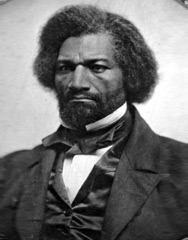 Frederick Douglass was a former slave, writer and social reformer who led the movement to abolish slavery. Douglass fought for the equality of all people, whether black, female, Native American or immigrants.
Frederick Douglass was a former slave, writer and social reformer who led the movement to abolish slavery. Douglass fought for the equality of all people, whether black, female, Native American or immigrants.
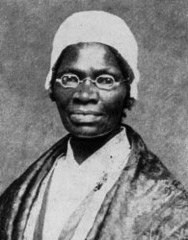 Sojourner Truth was a former slave who became a leader in the abolitionist and women’s rights movement. During the civil war, she recruited black troops, and later /worked to secure land grants from the US Government for former slaves.
Sojourner Truth was a former slave who became a leader in the abolitionist and women’s rights movement. During the civil war, she recruited black troops, and later /worked to secure land grants from the US Government for former slaves.
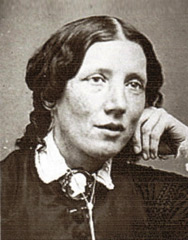 Harriett Beecher Stowe was an abolitionist and author who was best known for her novel Uncle Tom’s Cabin, which depicted the harsh lives of African Americans under slavery. It reached millions as a novel and play and helped energize anti-slavery forces.
Harriett Beecher Stowe was an abolitionist and author who was best known for her novel Uncle Tom’s Cabin, which depicted the harsh lives of African Americans under slavery. It reached millions as a novel and play and helped energize anti-slavery forces.
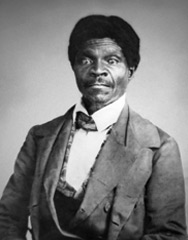 Dredd Scott was a slave who sued for his freedom and that of his wife and daughters. The US Supreme Court ruled against him, but his fight inspired public outrage which helped lead to the Civil War.
Dredd Scott was a slave who sued for his freedom and that of his wife and daughters. The US Supreme Court ruled against him, but his fight inspired public outrage which helped lead to the Civil War.
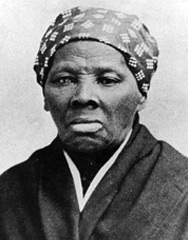 Harriett Tubman was an abolitionist and Union Spy who made thirteen missions to rescue enslaved families using a network of antislavery activists and safe houses known as the Underground Railroad. She also worked with abolitionist John Brown, recruiting men for his raid on Harper’s Ferry and was a proponent for women’s right to vote.
Harriett Tubman was an abolitionist and Union Spy who made thirteen missions to rescue enslaved families using a network of antislavery activists and safe houses known as the Underground Railroad. She also worked with abolitionist John Brown, recruiting men for his raid on Harper’s Ferry and was a proponent for women’s right to vote.
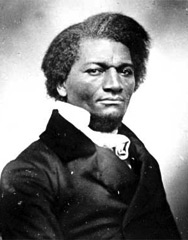 Nat Turner was an African-American slave who led a rebellion of slaves and free blacks in Southhampton County, Virginia the resulted in the deaths of 200 black people and 50 whites. Turner and 57 blacks accused of being part of the rebellion were tried, sentenced to death and hanged.
Nat Turner was an African-American slave who led a rebellion of slaves and free blacks in Southhampton County, Virginia the resulted in the deaths of 200 black people and 50 whites. Turner and 57 blacks accused of being part of the rebellion were tried, sentenced to death and hanged.
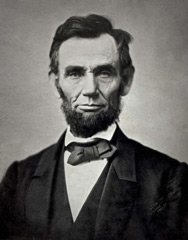 Abraham Lincoln was the 16th President of the United States, who led the United States during the Civil War and worked to abolish slavery. Challenged by Frederick Douglass, Sojourner Truth and others for what was seen as his evolving positions on slavery, Lincoln was successful in ending slavery when he signed the Emancipation Proclamation.
Abraham Lincoln was the 16th President of the United States, who led the United States during the Civil War and worked to abolish slavery. Challenged by Frederick Douglass, Sojourner Truth and others for what was seen as his evolving positions on slavery, Lincoln was successful in ending slavery when he signed the Emancipation Proclamation.
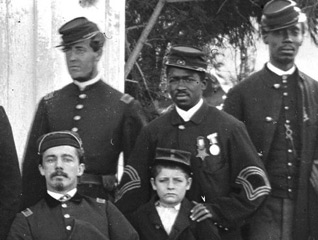 Comprising more than 175 regiments, 178,000 African American soldiers fought side-by-side White Soldiers during the Civil War. By the end of the war, they comprised nearly one-tenth of all Union troops.
Comprising more than 175 regiments, 178,000 African American soldiers fought side-by-side White Soldiers during the Civil War. By the end of the war, they comprised nearly one-tenth of all Union troops.
 Beginning in the 19th century, Chinese immigrants were brought to the U.S. to work as laborers, and helped build the transcontinental railroad and worked in the mining industry. They suffered racial discrimination at every level of society, and were vilified by the mainstream media as “The Yellow Peril” and blamed for taking jobs.
Beginning in the 19th century, Chinese immigrants were brought to the U.S. to work as laborers, and helped build the transcontinental railroad and worked in the mining industry. They suffered racial discrimination at every level of society, and were vilified by the mainstream media as “The Yellow Peril” and blamed for taking jobs.
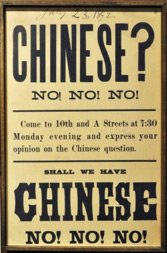 In 1882, Congress passed the Chinese Exclusion Act, which prohibited immigration from China. These laws prevented new immigration and prevented the reunion of the families of thousands of Chinese men with had left China to work in the US without their families.
In 1882, Congress passed the Chinese Exclusion Act, which prohibited immigration from China. These laws prevented new immigration and prevented the reunion of the families of thousands of Chinese men with had left China to work in the US without their families.
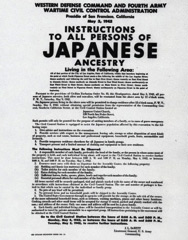
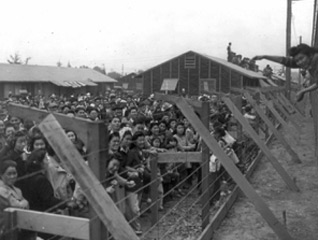 Following the bombing of Pearl Harbor, President Franklin Roosevelt signed Executive Order 9066, ordering the forced removal of 110,000 Japanese Americans from the west coast into desolate internment camps in the interior of the country. Although 63% were US citizens, and not a single act of espionage was ever proven, the internment was upheld in Korematsu v. US, which was later overturned 40 years later.
Following the bombing of Pearl Harbor, President Franklin Roosevelt signed Executive Order 9066, ordering the forced removal of 110,000 Japanese Americans from the west coast into desolate internment camps in the interior of the country. Although 63% were US citizens, and not a single act of espionage was ever proven, the internment was upheld in Korematsu v. US, which was later overturned 40 years later.
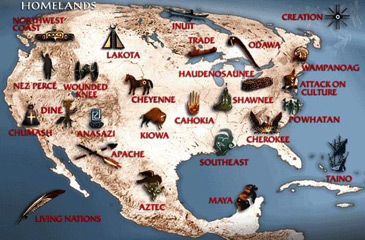
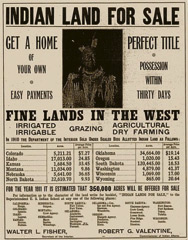 Between 1776 and the present, the United States seized some 1.5 billion acres from North America’s native peoples, an area 25 times the size of the United Kingdom. It has been estimated that 100 million Native Americans were slaughtered.
Between 1776 and the present, the United States seized some 1.5 billion acres from North America’s native peoples, an area 25 times the size of the United Kingdom. It has been estimated that 100 million Native Americans were slaughtered.
 Sitting Bull was a Lakota Holy Man who inspired the victory at the Battle of Little Bighorn and led his people during years of resistance to US policies. H e was killed by Indian agency police when they feared he would join the Ghost Dance movement, which advocated for the taking back of Native American lands.
Sitting Bull was a Lakota Holy Man who inspired the victory at the Battle of Little Bighorn and led his people during years of resistance to US policies. H e was killed by Indian agency police when they feared he would join the Ghost Dance movement, which advocated for the taking back of Native American lands.
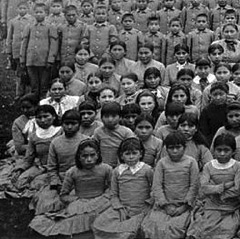 Established in the 19th century by Christian missionaries, Native American boarding schools, which separated children from their families and tribes, were designed to assimilate Native Americans to European culture. By 1973, 60,000 children were enrolled in the school, and later investigation revealed documented cases of sexual, physical and mental abuse suffered by the children at the schools.
Established in the 19th century by Christian missionaries, Native American boarding schools, which separated children from their families and tribes, were designed to assimilate Native Americans to European culture. By 1973, 60,000 children were enrolled in the school, and later investigation revealed documented cases of sexual, physical and mental abuse suffered by the children at the schools.
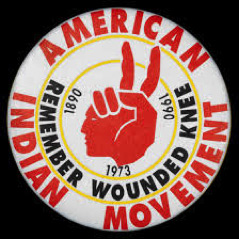 The American Indian Movement (AIM) was formed in 1968 to address Native American sovereignty, treaty issues, police harassment and racism against Native Americans. AIM participated in the occupation of the abandoned federal prison Alcatraz from 1969-1971 and opposes sports teams using figures of Native Americans as mascots and team names.
The American Indian Movement (AIM) was formed in 1968 to address Native American sovereignty, treaty issues, police harassment and racism against Native Americans. AIM participated in the occupation of the abandoned federal prison Alcatraz from 1969-1971 and opposes sports teams using figures of Native Americans as mascots and team names.
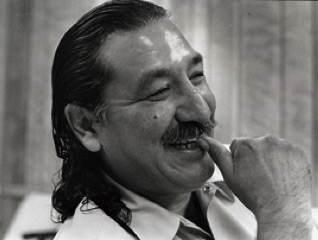 Leonard Peltier is a Native American activist and AIM member who was convicted of first degree murder in the deaths of two FBI agents and sentenced to two life terms. Peltier has denied involvement in the killing and the protests concerning the fairness of his trial and the evidence used against him has drew the support of Amnesty International, the late John Lennon, Nelson Mendela and countless others.
Leonard Peltier is a Native American activist and AIM member who was convicted of first degree murder in the deaths of two FBI agents and sentenced to two life terms. Peltier has denied involvement in the killing and the protests concerning the fairness of his trial and the evidence used against him has drew the support of Amnesty International, the late John Lennon, Nelson Mendela and countless others.

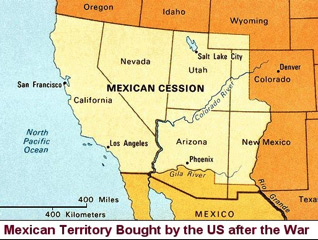 As part of the American territorial expansion to the Pacific Coast, the Mexican-American war resulted in the Mexican annexation of California, Utah and New Mexico to the United States for $15 million. The war was very controversial in the United States, with anti-slavery and anti-imperialist strongly opposed, and left many Mexican citizens separated from their national government.
As part of the American territorial expansion to the Pacific Coast, the Mexican-American war resulted in the Mexican annexation of California, Utah and New Mexico to the United States for $15 million. The war was very controversial in the United States, with anti-slavery and anti-imperialist strongly opposed, and left many Mexican citizens separated from their national government.
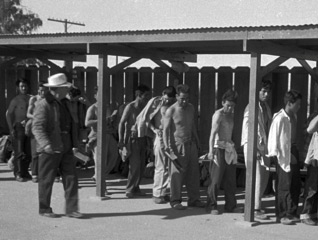
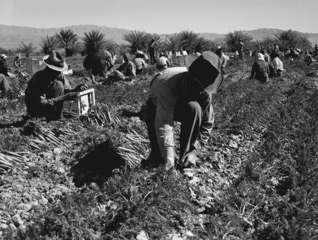 The Bracero Program meaning “manual laborer” in Spanish was a series of laws and agreements resulting from the Mexican Farm Labor Agreement with Mexico. The agreement enabled the importation of contract laborers from Mexico to the US to supply workers during the early phases of WWII.
The Bracero Program meaning “manual laborer” in Spanish was a series of laws and agreements resulting from the Mexican Farm Labor Agreement with Mexico. The agreement enabled the importation of contract laborers from Mexico to the US to supply workers during the early phases of WWII.
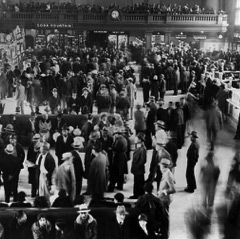 Following the Mexican-American War, with a scarcity of jobs during the Depression, more than a million people of Mexican descent were sent to Mexico. 60 percent were American citizens.
Following the Mexican-American War, with a scarcity of jobs during the Depression, more than a million people of Mexican descent were sent to Mexico. 60 percent were American citizens.
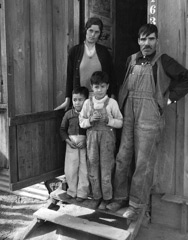
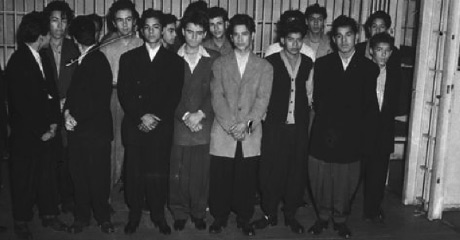 The Zoot Suit Riots were a series of racist attacks in 1943 that broke out in Los Angeles when U.S. sailors and marines attacked Mexican, Filipino and African American youth, identified by the zoot suits they wore, as being unpatriotic. Over 500 Latino youth were arrested by police.
The Zoot Suit Riots were a series of racist attacks in 1943 that broke out in Los Angeles when U.S. sailors and marines attacked Mexican, Filipino and African American youth, identified by the zoot suits they wore, as being unpatriotic. Over 500 Latino youth were arrested by police.
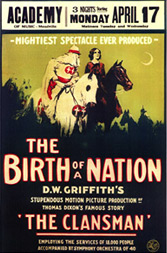 The Birth of a Nation is a 1915 American silent film which portrayed the Klu Klux Klan and the Confederate South in a heroic light and drew widespread protests by African Americans against the film. In 2016, filmmaker Nate Parker would choose the same title for his film about Nat Turner.
The Birth of a Nation is a 1915 American silent film which portrayed the Klu Klux Klan and the Confederate South in a heroic light and drew widespread protests by African Americans against the film. In 2016, filmmaker Nate Parker would choose the same title for his film about Nat Turner.
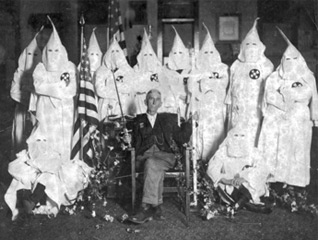
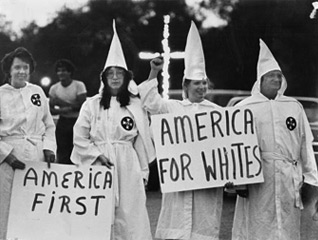 Founded in 1866, the Ku Klux Klan (KKK) extended into every southern state and became a vehicle for white southern resistance to Reconstruction-era policies aimed at establishing political and economic equality for blacks. Known for burning crosses and staging rallies, parades and marches denouncing immigrants, Catholics, Jews, blacks and organized labor, the KKK’s reign of terror included lynchings, bombings of black schools and churches and violence against black and white activists in the South.
Founded in 1866, the Ku Klux Klan (KKK) extended into every southern state and became a vehicle for white southern resistance to Reconstruction-era policies aimed at establishing political and economic equality for blacks. Known for burning crosses and staging rallies, parades and marches denouncing immigrants, Catholics, Jews, blacks and organized labor, the KKK’s reign of terror included lynchings, bombings of black schools and churches and violence against black and white activists in the South.
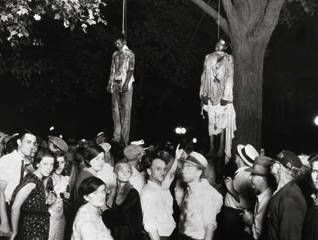 Lynching attacks on African Americans in the South increased dramatically in the aftermath of the Civil War. Nearly 3,500 African Americans were lynched between 1883 to 1920.
Lynching attacks on African Americans in the South increased dramatically in the aftermath of the Civil War. Nearly 3,500 African Americans were lynched between 1883 to 1920.
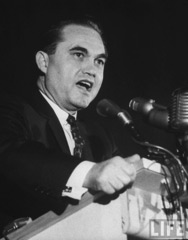 George Wallace was the Governor of Alabama who advocated for segregation and ran unsuccessfully for President of the United States four times. In 1963, Wallace attempted to block four black students from enrolling in elementary schools in Huntsville, but a federal court ordered the children to be admitted.
George Wallace was the Governor of Alabama who advocated for segregation and ran unsuccessfully for President of the United States four times. In 1963, Wallace attempted to block four black students from enrolling in elementary schools in Huntsville, but a federal court ordered the children to be admitted.
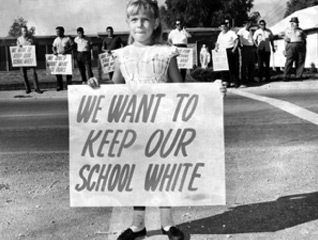 Jim Crow laws were federal, state and local laws which enforced racial segregation in the South. These laws included private covenants allowing housing segregation, bank lending practices, segregated public schools, public places, transportation, restrooms, restaurants and drinking fountains and even US Military service.
Jim Crow laws were federal, state and local laws which enforced racial segregation in the South. These laws included private covenants allowing housing segregation, bank lending practices, segregated public schools, public places, transportation, restrooms, restaurants and drinking fountains and even US Military service.
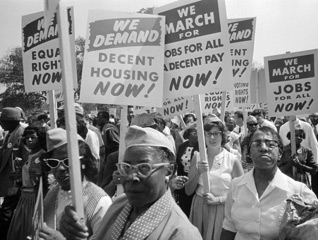 The Civil Rights Movement encompassed social justice movements in the U.S. organized to end racial segregation and discrimination against African Americans and other minorities, and to secure legal recognition and federal protection of the rights guaranteed by the Constitution. Some of the major achievements of the movement was the passage of the Civil Rights Act of 1964, which banned discrimination based on race, color, religion, sex or national origin in employment and education, the Voting Rights Act of 1965, which protected voting rights, and the Fair Housing Act of 1968, which banned discrimination in the sale or rental of housing.
The Civil Rights Movement encompassed social justice movements in the U.S. organized to end racial segregation and discrimination against African Americans and other minorities, and to secure legal recognition and federal protection of the rights guaranteed by the Constitution. Some of the major achievements of the movement was the passage of the Civil Rights Act of 1964, which banned discrimination based on race, color, religion, sex or national origin in employment and education, the Voting Rights Act of 1965, which protected voting rights, and the Fair Housing Act of 1968, which banned discrimination in the sale or rental of housing.
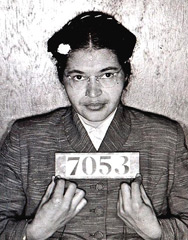 On December 1, 1955, Rosa Parks was arrested after she refused to obey bus driver’s order to give up her seat in the colored section to a white passenger after the white section of the bus as filled. Her act of defiance became a symbol of the resistance to racial segregation civil rights movement.
On December 1, 1955, Rosa Parks was arrested after she refused to obey bus driver’s order to give up her seat in the colored section to a white passenger after the white section of the bus as filled. Her act of defiance became a symbol of the resistance to racial segregation civil rights movement.
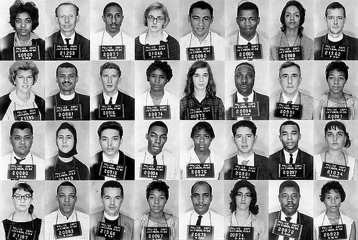 The Freedom Riders were civil rights activists who rode interstate buses in mixed racial groups to challenge segregated public buses in southern states that had ignored federal laws prohibiting discrimination. Riders’ arrests for trespassing, unlawful assembly and violating Jim Crow laws, along with sit-ins against segregated lunch counters and boycotts of stores that maintained segregated facilities, brought nation attention to the non-enforcement of civil rights.
The Freedom Riders were civil rights activists who rode interstate buses in mixed racial groups to challenge segregated public buses in southern states that had ignored federal laws prohibiting discrimination. Riders’ arrests for trespassing, unlawful assembly and violating Jim Crow laws, along with sit-ins against segregated lunch counters and boycotts of stores that maintained segregated facilities, brought nation attention to the non-enforcement of civil rights.
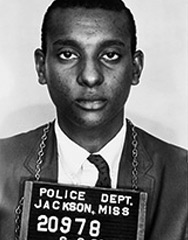 Stokley Carmichael was among those arrested in the Freedom Rider protests and was one of the most well-known activists of the Civil Rights Movement through his involvement in the Student Nonviolent Coordinating Committee, the Black Panther Party and the All-African Peoples Revolutionary Party. His “Black Power” speech, where he urged black pride and economic independence, became a rallying cry of the movement.
Stokley Carmichael was among those arrested in the Freedom Rider protests and was one of the most well-known activists of the Civil Rights Movement through his involvement in the Student Nonviolent Coordinating Committee, the Black Panther Party and the All-African Peoples Revolutionary Party. His “Black Power” speech, where he urged black pride and economic independence, became a rallying cry of the movement.
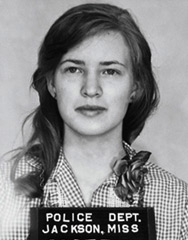 Joan Trumpauer Mulholland is a civil rights activist and Freedrom Rider who took part in sit-ins. She left a comfortable life with a wealth family to join the civil rights movement and was even hunted down by the KKK for her involvement.
Joan Trumpauer Mulholland is a civil rights activist and Freedrom Rider who took part in sit-ins. She left a comfortable life with a wealth family to join the civil rights movement and was even hunted down by the KKK for her involvement.
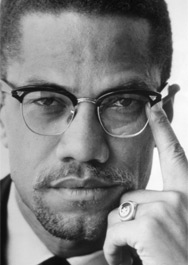 Malcolm X was an American Muslim Minister and a courageous advocate for the rights of African-Americans and other oppressed people. Initially in favor of the separation of blacks and whites as a minister for the Nation of Islam, Malcolm X later repudiated racism and became one of the movement’s most influential and articulate leaders, uniting people to fight for self-determination and identity.
Malcolm X was an American Muslim Minister and a courageous advocate for the rights of African-Americans and other oppressed people. Initially in favor of the separation of blacks and whites as a minister for the Nation of Islam, Malcolm X later repudiated racism and became one of the movement’s most influential and articulate leaders, uniting people to fight for self-determination and identity.
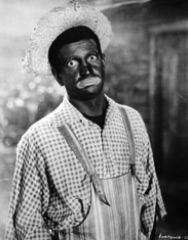 Blackface was a form of theatrical makeup used by white actors to represent a black person which gained popularity in the 19th century. This practice proliferated stereotypes of black people and racist images, attitudes and perceptions.
Blackface was a form of theatrical makeup used by white actors to represent a black person which gained popularity in the 19th century. This practice proliferated stereotypes of black people and racist images, attitudes and perceptions.
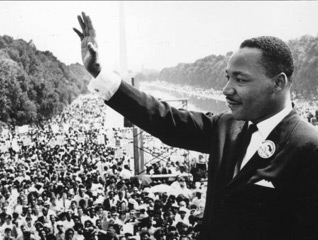 Martin Luther King, Jr. was an American Baptist minister, activist and leader in the Civil Rights Movement who advocated for the advancement of civil rights using nonviolent civil disobedience. King led the Montgomery Bus Boycott, helped found the Southern Christian Leadership Council and helped organized the Selma to Montgomery marches.
Martin Luther King, Jr. was an American Baptist minister, activist and leader in the Civil Rights Movement who advocated for the advancement of civil rights using nonviolent civil disobedience. King led the Montgomery Bus Boycott, helped found the Southern Christian Leadership Council and helped organized the Selma to Montgomery marches.
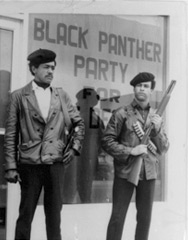 The Black Panther Party for Self-Defense, founded by Huey Newton and Bobby Seale, was a revolutionary black nationalist organization known for its armed patrols in order to monitor and challenge police brutality in Oakland, community health clinics and a free breakfast program for children. J. Edgar Hoover, the director of the FBI called the party “the greatest threat to the security of the country” and mounted the COINTELPRO operation in order to criminalize, assassinate and discredit party members.
The Black Panther Party for Self-Defense, founded by Huey Newton and Bobby Seale, was a revolutionary black nationalist organization known for its armed patrols in order to monitor and challenge police brutality in Oakland, community health clinics and a free breakfast program for children. J. Edgar Hoover, the director of the FBI called the party “the greatest threat to the security of the country” and mounted the COINTELPRO operation in order to criminalize, assassinate and discredit party members.
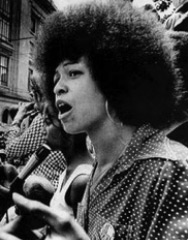 Angela Davis is an American activist, professor and author. She was a leader of the Communist Party and worked closely with the Black Panther Party. She was tried and acquitted for her alleged involvement in attempting to free George Jackson and the Soledad Brothers, a group of revolutionary prisoners, and later founded Critical Resistance, an organization to abolish the prison-industrial complex.
Angela Davis is an American activist, professor and author. She was a leader of the Communist Party and worked closely with the Black Panther Party. She was tried and acquitted for her alleged involvement in attempting to free George Jackson and the Soledad Brothers, a group of revolutionary prisoners, and later founded Critical Resistance, an organization to abolish the prison-industrial complex.
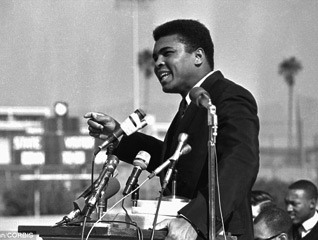 Muhammad Ali, an American professional boxer and one of the greatest heavyweights in the history of boxing, became one of the leading figures in the civil rights movement. Ali first became a Muslim and then took a principled position against joining the draft, refusing to go to Vietnam to kill Asian people “who had done nothing to (him).”
Muhammad Ali, an American professional boxer and one of the greatest heavyweights in the history of boxing, became one of the leading figures in the civil rights movement. Ali first became a Muslim and then took a principled position against joining the draft, refusing to go to Vietnam to kill Asian people “who had done nothing to (him).”
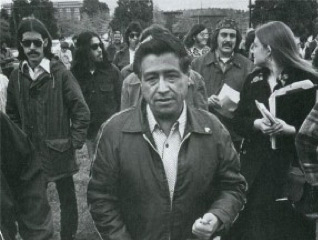 Cesar Chavez was an American farm worker, labor leader and civil rights activist who cofounded the United Farm Workers (UFW) union. His aggressive but nonviolent tactics made the farm workers’ struggle a moral cause with nationwide support.
Cesar Chavez was an American farm worker, labor leader and civil rights activist who cofounded the United Farm Workers (UFW) union. His aggressive but nonviolent tactics made the farm workers’ struggle a moral cause with nationwide support.
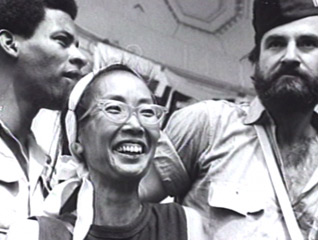 Yuri Kochiyama was a former internee and Japanese American activist who was a friend of Malcolm X’s and a member of his Organization of Afro-American Unity. She was involved in many causes including joining with Puerto Ricans who took over the Statue of Liberty to draw attention to the struggle for Puerto Rican independence and working on behalf of political prisoners and reparations for Japanese Americans.
Yuri Kochiyama was a former internee and Japanese American activist who was a friend of Malcolm X’s and a member of his Organization of Afro-American Unity. She was involved in many causes including joining with Puerto Ricans who took over the Statue of Liberty to draw attention to the struggle for Puerto Rican independence and working on behalf of political prisoners and reparations for Japanese Americans.
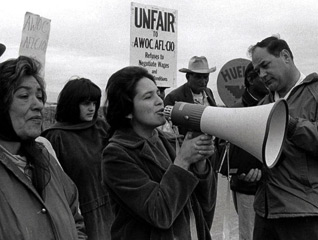 Delores Huerta is an American labor leader and civil rights activist who helped co-found the United Farm Workers with Cesar Chavez. She was instrumental in advocating for workers, immigrants and women’s rights, including the 1975 California Agricultural Labor Relations Act.
Delores Huerta is an American labor leader and civil rights activist who helped co-found the United Farm Workers with Cesar Chavez. She was instrumental in advocating for workers, immigrants and women’s rights, including the 1975 California Agricultural Labor Relations Act.
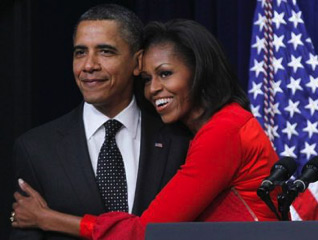 On July 20,2009, Barack Obama, with First Lady Michelle Obama at his side, was sworn in as the 44th President of the United States and the first African American to ever hold the office. During his first campaign for President, Obama gave a speech titled “A More Perfect Union,” addressing the subjects of racial tension, white privilege and race and inequality in the U.S.
On July 20,2009, Barack Obama, with First Lady Michelle Obama at his side, was sworn in as the 44th President of the United States and the first African American to ever hold the office. During his first campaign for President, Obama gave a speech titled “A More Perfect Union,” addressing the subjects of racial tension, white privilege and race and inequality in the U.S.
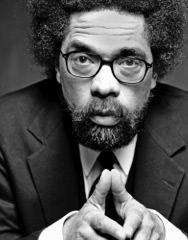 Dr. Cornel West is an American social activist, academic and iconic public figure. The first African American to graduate from Princeton with a PhD, Dr. West taught at Harvard and also served as Professor of African American Studies at Princeton.
Dr. Cornel West is an American social activist, academic and iconic public figure. The first African American to graduate from Princeton with a PhD, Dr. West taught at Harvard and also served as Professor of African American Studies at Princeton.
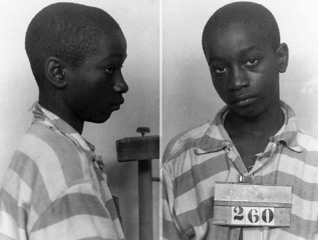 George Stinney Jr. was an African-American youth convicted of murder in South Carolina in 1944 and the youngest person in the 20th century to be sentenced to death and murder. His conviction was later vacated 70 years after his execution on the grounds that he had not been given a fair trial and had no effective defense.
George Stinney Jr. was an African-American youth convicted of murder in South Carolina in 1944 and the youngest person in the 20th century to be sentenced to death and murder. His conviction was later vacated 70 years after his execution on the grounds that he had not been given a fair trial and had no effective defense.
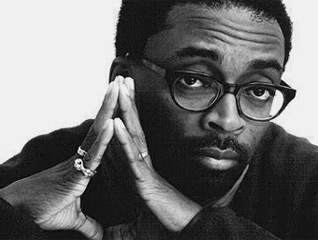 Spike Lee is an American film director, producer, writer and actor. He has produced over 35 films, many of which examined race relations, including 1989’s Do the Right Thing, about racial tensions in a Brooklyn neighborhood, and 2000’s Bamboozled, satire about blackface actors.
Spike Lee is an American film director, producer, writer and actor. He has produced over 35 films, many of which examined race relations, including 1989’s Do the Right Thing, about racial tensions in a Brooklyn neighborhood, and 2000’s Bamboozled, satire about blackface actors.
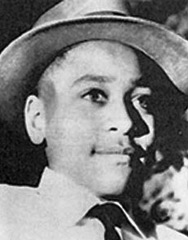 Emmett Till was an African-American teenager who was lynched in Mississippi at the age of 14, after reportedly flirting with a white woman. Two men abducted him and beat, mutilated and shot him and were acquitted of his murder, but the case was a catalyst which ignited the Civil Rights movement.
Emmett Till was an African-American teenager who was lynched in Mississippi at the age of 14, after reportedly flirting with a white woman. Two men abducted him and beat, mutilated and shot him and were acquitted of his murder, but the case was a catalyst which ignited the Civil Rights movement.

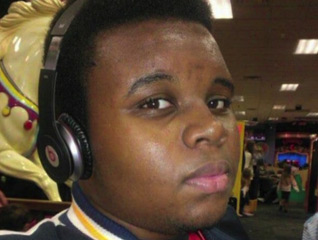
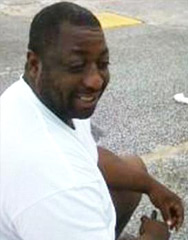 The tragic shootings and deaths of Trayvon Martin, Michael Brown, Eric Garner, Jordan Russell, Tamir Rice, Oscar Grant, Mario Woods, Sandra Bland, and many, many other boys, girls, men and women of color, began the nation’s awakening to the heavy weight of police brutality, shootings and racial profiling borne by African Americans, men and boys in particular. Many incidents were captured on video and spread on social media, exposing and boosting the awareness of what had long been happening in America’s communities of color.
The tragic shootings and deaths of Trayvon Martin, Michael Brown, Eric Garner, Jordan Russell, Tamir Rice, Oscar Grant, Mario Woods, Sandra Bland, and many, many other boys, girls, men and women of color, began the nation’s awakening to the heavy weight of police brutality, shootings and racial profiling borne by African Americans, men and boys in particular. Many incidents were captured on video and spread on social media, exposing and boosting the awareness of what had long been happening in America’s communities of color.
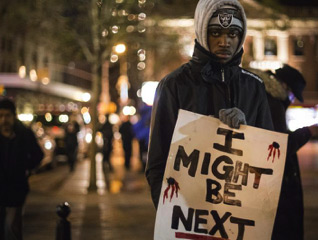
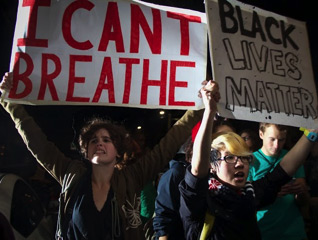 Black Lives Matter is an international activist movement, originating in the African American community, that campaigns against violence toward black people. BLM organizes protests around the deaths of people of color by law enforcement and advocates for the issues of racial profiling, police brutality and racial inequality in the criminal justice system.
Black Lives Matter is an international activist movement, originating in the African American community, that campaigns against violence toward black people. BLM organizes protests around the deaths of people of color by law enforcement and advocates for the issues of racial profiling, police brutality and racial inequality in the criminal justice system.

